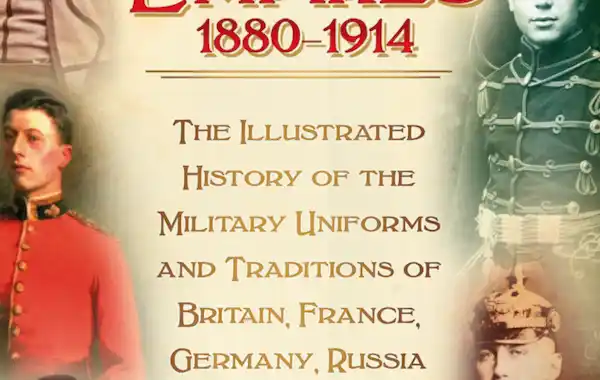17 August 2018
|
Many family history researchers become interested in learning about the regiments their ancestors served in. Here military history expert Wendell Schollander reveals a British regiment he is particularly drawn to, which has been involved in more major disasters than any other...
Many family history researchers become interested in learning about the regiments their ancestors served in. Here military history expert Wendell Schollander reveals a British regiment he is particularly drawn to, which has been involved in more major disasters than any other...
Military history expert Wendell Schollander, author of Glory of the Empires 1880-1914: The Illustrated History of the Military Uniforms and Traditions of Britain, France, Germany, Russia and the United States, reveals a fascinating series of disasters that made the 44th East Essex Regiment the 'unluckiest' in the British Army.
It is not uncommon for people doing family history research to become interested in the regiments their ancestors served in. From there it is only a short step to developing a second hobby of studying the history and/or uniforms of the British Army and its regiments.
One regiment I’ve always been drawn to is the 44th East Essex Regiment, maybe the unluckiest regiment in the British Army. It has probably been involved in more major disasters than any regiment in the Army.
A forerunner of the regiment was at the battle of Prestonpans, eight miles from Edinburgh, in 1745. There it and other loyal royal regiments were routed in 10 minutes by the wild charge of highland clans loyal to Bonnie Price Charles, the young pretender to the throne of England and Scotland. Out of three infantry regiments, including one that became the 44th Regiment, 1,500 infantry were casualties. Of these 400 were killed, over a thousand captured and only 170 escaped. (*1)
The 44th Regiment was sent to America to take part in a 1755 expedition against a French fort, Fort Duquesne, at a strategic point near where Pittsburgh, Pennsylvania, is now located. A large army of two British regiments, one of which was the 44th, many Colonial (called provincials) companies and regiments was formed. Its commander was Major-General Edward Braddock. This expedition has come to be known in America as Braddock’s Defeat.
This army built a narrow, 3.66 meter (four-yard) wide, road through the trackless forest (*2) for a distance of 185 kilometres (115 miles).
The leading forces of the British Army encountered French troops and Indian warriors near Fort Duquesne. The Indians fired from behind trees and the British soldiers, trained to fire together in volleys, were stymied. At last panic set in. British and provincial men ran back along the road and left their wounded to be tortured and killed. The only thing that kept the entire army from being massacred was that after three hours the undisciplined Indians stopped their firing and pursuit to take scalps and loot the baggage train. (*3)
When the army stopped running it was estimated that about one third of the men had been killed and one third wounded (*4). Every officer of the 44th was killed or wounded. (*5)
The 44th also took part in the British attack on the French stronghold at Ticonderoga (located in what is now the state of New York). The 44th was one of seven British regiments, plus provincial troops, called upon to make a direct assault against strong breastworks. Six attacks were made over six hours. All failed. British losses were extremely high. The Black Watch was almost wiped out, losing close to 500 men (*6). The 44th lost about 200 men (*7), about a third of its strength. The other regiments had similar, albeit slightly lower losses.
Bad as these were, the 44th is best known for the disaster that it suffered in 1842 in the First Afghan War. The regiment was in Kabul as part of an occupying British army. It had about 25 officers and 600 other ranks (*8). Eventually, the British situation became untenable and the British Army agreed to withdraw under a safe conduct truce.
The army that was to leave Kabul on a cold bitter January 6, 1842, was a large force. It numbered some 4,500 fighting men (the 44th and seven Indian regiments) plus twelve to fifteen thousand camp followers, which every Indian army seemed to need to function and an unknown number of the camp followers’ women and children. (*9)
Once the march out began, Afghans immediately began attacking the British army and its camp followers in violation of the truce. The army and followers dwindled down to 20 officers, 50 to 70 men of the 44th, six artillerymen, four or five sepoys and about 300 followers on 11 January (*10). The rest of that vast army had been shot, desert6ed, or frozen. A very few had become captives.
On the 11th, a small party of horsemen left the army to try to reach the British strong point at Jalalabad (*11). Only one made it.
The balance of the army kept pressing on and being fired upon. At last, on the 13th near the village of Gandamack the survivors, with their way blocked and ammunition almost all gone, were forced to make a last stand. After exchanging gunfire with some 800 to 900 surrounding tribesmen, the survivors charged into the mass of tribesmen. Almost all were killed in the hand to hand fighting that followed. A Lt Souter and seven other ranks of the 44th were over come and taken captive. Also taken captive were four other British soldiers (*12). It is said that Souter was not killed because he had wound the regimental flag around his waist to try to save it. The tribesmen seeing its rich decorations thought he must be a wealthy man and kept him alive for ransom.
Except for these eight men, the 44th Regiment was totally wiped out.
The retreat from Kabul and the destruction of the British army is considered the worse disaster suffered by a British Army in the 19th century.
Having the regiment wiped out seemed to end the worst of the curse that had hung over the regiment for so many years. But, the 44th’s, and its descendant, the 1st Battalion of The Essex Regiment’s, string of bad luck, while not as bad as what had gone before, continued down through World War II. But, that is another story.
• You can view The Last Stand at Gundamuck, an oil painting by William Barnes Wollen in 1898, depicting the defeat of the Essex Regiment in Afghanistan in 1841 at the Essex Regiment Museum in Chelmsford.
* Bibliography
1 A History of the British Army, vol II. J. W. Fortfscue. pp 129-31.
2 Ibid p.278
3 Braddock’s Defeat, David Preston p. 262-63
4 Ibid p.277
5 Ibid p.341-2, 6 killed, 1 wounded that died later, and 9 wounded.
6 A History of the British Army, vol II. J. W. Fortfscue. p.337
7 Ibid
8 History of the British Army, Vol. XII,, J. W. Fortfscue, p 230
9 Ibid p. 230-31
10 Ibid pp. 241-42.
11 Ibid. p 241 The only one to make it was Dr Brydon. He was the sole uncaptured survivor of that vast host of humanity that had left Kabul just a few days before.
12 Chelmsford Museum (Museum of the Essex Regiment) and The Journal of the Royal Anglian Regiment Special Features, Ganamack Revisited.
• Glory of the Empires 1880-1914: The Illustrated History of the Military Uniforms and Traditions of Britain, France, Germany, Russia and the United States by Wendell Schollander is published in hardback by The History Press (RRP £50).
• This article may also interest you:
Top free military websites for family history










